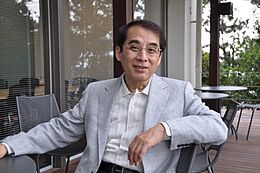Akira Tonomura facts for kids
Quick facts for kids
Akira Tonomura
|
|
|---|---|

Tonomura in 2009
|
|
| Born | April 25, 1942 Hyōgo, Japan
|
| Died | May 2, 2012 (aged 70) |
| Nationality | Japanese |
| Known for | development of electron holography |
| Awards | Japan Academy Prize (1991) The Franklin Medal (1999) |
| Scientific career | |
| Fields | Physics |
Akira Tonomura (born April 25, 1942 – died May 2, 2012) was a Japanese physicist. He was famous for his work with electron holography. He also proved an important idea called the Aharonov–Bohm effect.
Contents
Who Was Akira Tonomura?
Akira Tonomura was a brilliant scientist from Japan. He spent his life studying tiny particles and how they behave. His discoveries helped us understand the world at a very small scale.
Early Life and Career
Tonomura was born in Hyōgo, Japan. He studied physics at the University of Tokyo. After he graduated, he started working at the Hitachi Central Research Laboratory. He became a "Fellow" there in 1999. This is a special title for top scientists.
Seeing the Invisible: Electron Holography
In the 1970s, Tonomura did amazing work with something called an electron holography microscope. This special microscope uses electrons to create images. It's like a super-powerful camera for tiny things. With it, he was the first person ever to see magnetic force lines. These are the invisible lines that show how magnetism works.
The Aharonov–Bohm Effect Explained
Building on his work, Tonomura did another big experiment in 1986. He proved something called the Aharonov–Bohm effect. This idea had been around for a long time, but no one could prove it.
The Aharonov–Bohm effect shows that electrons can be affected by magnetic forces even when they are not directly touching the magnetic field. It's like an invisible influence. This experiment proved that something called "vector potentials" are real. These are mathematical ideas that are actually more important than just electric or magnetic fields alone.
Studying Superconductors
Tonomura also studied superconductors. These are special materials that can carry electricity without any resistance. He watched how tiny magnetic swirls, called magnetic vortices, moved inside these materials. His observations helped scientists understand superconductors better.
Awards and Recognition
Akira Tonomura received many important awards for his scientific work.
- He won the Japan Academy Prize in 1991.
- He also received The Franklin Medal in 1999.

